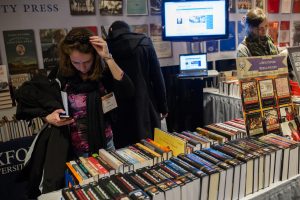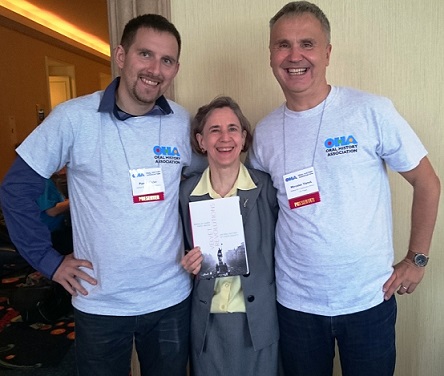On the first day of the AHA’s annual meeting, the most senior editors, the youngest marketing assistants, and anyone else representing a publisher are on their hands and knees in the Exhibit Hall unpacking skids full of books. We pray that all the boxes have arrived, and then we artfully arrange a display of the last year’s publishing efforts. In a few short hours, unruly stacks of cardboard boxes morph into a Potemkin Palace of history books. That Exhibit Hall is the best place on earth—and these days, often the only place—for scholars to actually peruse our new publications, especially the specialist monographs. They also get welcome discounts.

Attendees browse the Oxford University Press booth at the AHA annual meeting in New York. Credit: Marc Monaghan
Editors attending conferences wear many hats. Primarily, we’re there as hunters and gatherers, looking for the next great books in our field. We do that by attending sessions, talking to our longtime colleagues and advisers, including series editors and existing authors, and meeting with potential new authors, both in formal appointments and spontaneous conversations in the booth, the elevators, and the hallways. I signed one handbook editor while waiting for an interminably slow elevator at the San Diego Marriott.
As talent scouts, we judge work that has already been done. Editors thus spend some of their time listening to papers and scoping out new talent. The “yield” is fairly low, but it’s a good way to check out potential authors. It tells us not only whether a particular historian has a good argument, but whether s/he is a decent human being. Public behavior is telling! Does s/he get to the point? How does the scholar react to questions and criticism? I also meet with potential authors who have written to me in advance and sent me proposals or sample materials. The conference is a chance for me to hear more about the project, to ask questions about what I’ve read, and often to guide the author in a slightly different direction. I’ll ask about competing titles, about sources, and, as at sessions, I’ll get a feel for the style of the person I’m dealing with.
Unfortunately, time is always short. So when meeting with an editor, authors should get to the point. The proverbial “elevator pitch” is no joke—we need a quick overview of the subject matter, the status of the book, and the archival work you’ve done. If the book has grown out of a dissertation, who was your adviser? That information often orients us intellectually. Think of the meeting as speed dating for scholars and editors—make a good first impression. Many university press editors are also commissioning books, especially for existing series. After consulting with series editors and doing some research, I will have identified potential authors for particular titles and set up meetings to discuss the possibilities. That’s where I wear my snake-charmer hat.
Editors always make time to chat informally with potential authors to see if we can find the perfect new project based both on the scholar’s interests and our needs as publishers. It’s kismet when those two objectives align. For example, I had worked with Frans Coetzee and Marilyn Shevin-Coetzee on a World War I primary source anthology; I hoped to do another book with them. When we met at the AHA’s annual meeting several years ago, they told me that they had many more diaries they’d come across but had not had space to include. The result of that conversation was Commitment and Sacrifice: Personal Diaries from the Great War (2015), a collection of six rare and diverse war journals.
I also meet with authors who are already under contract—sometimes just to remind them that I’m alive and waiting. Having a deadline is good for everyone, and needing to get me a sample chapter in advance of a conference is very effective motivation. The annual meeting is also an opportunity to work through questions that have arisen in the course of writing and to review illustration programs in person. When we meet, I function as cheerleader, taskmaster, and sometimes lion tamer.

Pavel Mücke and Miroslav Vanek celebrate the publication of their book Velvet Revolutions: An Oral History of Czech Society with their OUP editor, Nancy Toff, at the Oral History Association conference in 2016.
Even though editors are heavily booked before they ever get on the plane, most of us also spend some unscheduled time in the booth. Good times to find us are at the beginning or end of the day—or when we’re running an event in the booth, such as a signing or coffee hour. We tend to return to the booth to meet our next appointment on the hour and half-hour, so scholars seeking a quick word would do well to show up at X:25 or X:55. Our marketing colleagues in the booth will have some idea of our schedules. (While you’re waiting, analyze the books in the booth to see if that press is a good fit for you. Are there other books in your subspecialty? Does the press publish trade books or monographs, document anthologies or textbooks?)
Booth time is useful to editors for a number of reasons: first, we can see what people are looking at or asking for. We can talk with them about what they like to teach with and what they don’t, and we can find out what they need but can’t find. Booth time is also when we talk with the predictable parade of assistant professors and postdocs who come by bearing proposals for their dissertation books. They all go away with the same advice: follow the instructions on the website, and mail or e-mail the proposal to the pertinent editor (the booth staff will be glad to tell you who that is). Even the nicest editors don’t want to haul home stacks of paper; we want to receive proposals in the office, where we can log them efficiently and consider them properly. But we are happy to answer short questions from would-be authors, direct them to the appropriate editor (which might be someone in another discipline or even at a different press), and answer editorial questions about published titles.
Senior scholars come by, too, and sometimes a query from a potential author will yield paydirt. This is the time when serendipity can strike. At the AHA’s annual meeting in 1997, for example, R. B. Bernstein, who was then teaching at New York Law School, came by the Oxford University Press booth. We chatted about his book Amending America (1993); he offered a Franklin biography; I countered with “I really need Jefferson”—and the rest, as they say, is history. That conversation ultimately led to a happy 20-year (and counting) publishing relationship. Richard’s award-winning Thomas Jefferson (2003) got a rave review on the front page of the New York Times Book Review, and his fifth OUP book, The Education of John Adams, will be published next year.
A similar conversation took place at the Berkshire Conference in Toronto two years ago: Ann Taylor Allen of the University of Louisville told me about her book on the history of German and American kindergartens. Fascinating, I said; my father attended a German-speaking kindergarten in New York City during World War I. A match was made, and Ann’s book, The Transatlantic Kindergarten, will make its debut at this year’s annual meeting.
We’re looking forward to showing off our handiwork in Denver—and finding some fabulous new books and authors. See you at the fair!
This post first appeared on AHA Today.
Nancy Toff is vice president and executive editor at Oxford University Press, where she edits a wide variety of history titles ranging from monographs to trade books. Her list includes the New Oxford World History series, the Oxford Oral History Series, Oxford History Handbooks, and the Very Short Introductions. She is also the author of four books on the history of the flute.
Tags: AHA Today 2017 Annual Meeting Scholarly Communication
Comment
Please read our commenting and letters policy before submitting.






